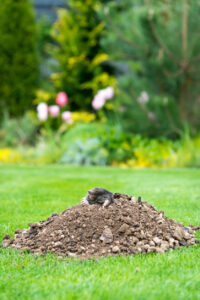
Need Help? Call Us On 0161 776 9832 For Expert Pest Control Advice On How To Identify Pest Infestations And Help Solve Your Pest Problem.
Oldham Mole Trapping and Control
The general public possesses some ideas about the meanderings of this particular creature. Even experts can not exactly pinpoint the nature and behaviour of the common mole. Moles spend most of their life underground and can not be reared in captivity because of their incredible food cravings.
 General Mole Facts
General Mole Facts
Here at Young Pest Control services, we have conducted extensive research into how the creature behaves. We know that moles are found across Europe, Asia, Southern Africa and North America. It is currently accepted that there are around 30 species, but more could exist. All mole species possess similar behaviour, with extreme exceptions in rarer species.
The Common Mole
This species in an insectivore and has an insatiable appetite. When it is fully grown an adult mole can grow up to 12-18cm and weigh 60 to 130 grams. A mole's long snout is recognisable and resembles that of the pig. A mole’s nose is virtually devoid of hair, aside from a few stray hairs on the tip. Many biologists agree that moles seek out their prey in the dark by using electronic and magnetic sensors in their nose. Moles possess little or no eyesight and use the other senses to thrive in their dark underworld.
Moles eyes are minuscule and are located, in most species, at the end of their nose. Moles eyes can only pick up light and nothing else. Moles do not have any recognisable ears, just holes covered by flaps of skin. Despite this, mole’s hearing is particularly acute and they rely on this in their underground world.
The mole’s head is streamlined and flattened and this is supported by a cylindrically shaped body. Its body is enclosed in a course, dark hair that possesses certain qualities. Each individual strand is thicker around the central part and this shields the mole when it is travelling freely through its tunnels. Importantly, it means the mole does not suffer any resistance as it moves.
This species has sturdy, robust front legs, which have a tendency to face outwards. Furthermore, its claws are particularly strong and create the tunnels it moves through. The mole possesses useless back legs that are comparable to a mouse’s. Nevertheless, they do propel the mole through the tunnels effortlessly and make it easier for it to move.
Oldham Mole Trapping
 When we come upon a well-used tunnel, then we will insert a small trowel to create an opening. Once the opening has been made, the trap can be inserted. Any loose soil should be excavated and the trap should be positioned squarely. The trigger will then correspond with movement within the run and the lower proportion of the trap will be set sensitively in the base of the tunnel.
When we come upon a well-used tunnel, then we will insert a small trowel to create an opening. Once the opening has been made, the trap can be inserted. Any loose soil should be excavated and the trap should be positioned squarely. The trigger will then correspond with movement within the run and the lower proportion of the trap will be set sensitively in the base of the tunnel.
The tunnel must then be recovered with slices of turf or alternatively with stones. Imperatively, the tunnel must be closed completely and must not let any light in. Putting soil back over the opening will make it appear as though nothing has been disturbed. Oldham mole trapping can be a very straightforward process if it left to the professionals.
Gassing Procedures
Gassing moles is another option if the infestation has become a problem. Here at Young’s Pest Control, we use Talunex Aluminium Phosphide for mole infestation control. Gas can be used in numerous situations when poisoning is not legally possible. We are permitted to professionally administer the gas into the creature’s tunnel system in order to exterminate the problem. Gassing is done in an extremely humane way and the problem is dealt with promptly.
Here at Young's Pest Control
If you have a mole infestation, then why not call the experts in dealing with Oldham mole trapping and control? Our team will guide you through the services that we offer, so we are able to tailor a job to your needs.
